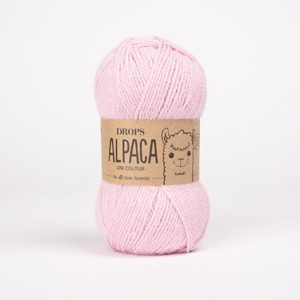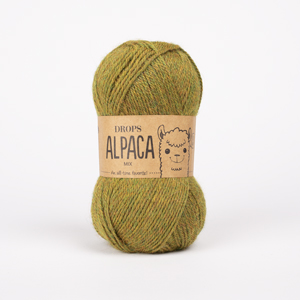Comments / Questions (10)
![]() De Jong wrote:
De Jong wrote:
Prachtig garen, maar het wasvoorschrift zegt: Verzorging: Handwas, max 30°C / Plat laten drogen / Viltbaar \r\nHet mag dus niet in de machine. De vraag is of dat wel zo handig is voor een babyvest.
26.11.2023 - 12:14
![]() Céline Bosse wrote:
Céline Bosse wrote:
Pour le modèle 2 ans, l’emmanchure a une ouverture de 17 cm alors que la manche mesure 14 centimètres. Il ne peut y avoir de correspondance entre les deux. En plus la manche sera attachée avec une partie du dos et devant en couleur naturel. Je ne comprends pas
06.01.2022 - 22:28DROPS Design answered:
Bonjour Mme Bosse, il manquait les 2 grandes tailles pour les emmanchures dos & devants (correction faite, merci), autrement dit, les emmanchures sont rabattues à 22 cm soit 15 cm d'emmanchure (hauteur totale 37 cm), comme indiqué dans le schéma. Si votre tension est juste vous avez bien 72 m = 30 cm soit 15 cm pliée en 2. La manche doit se terminer par M.2/M.3 = vous tricotez en naturel jusqu'à ce qu'il reste 5 cm avant la fin et tricotez alors M.2 puis M.3. Bon tricot!
07.01.2022 - 07:31
![]() Céline Bosse wrote:
Céline Bosse wrote:
Bonjour, Je tricote présentement le dos du chandail, j’ai 85 mailles, mais le patron M2 et M3 ne contient que 12 mailles ce qui est un nombre pair, alors même en tricotant sept fois le modèle il reste 3 mailles. Comment y arriver? Et il ne peut y avoir de mailles lisières. Pouvez-vous m’aider s’il vous plaît , merci
03.10.2021 - 23:31DROPS Design answered:
Bonjour Mme Bosse, répétez 7 fois les 12 mailles de M.2/M.3 et terminez par la 1ère maille de M.2/M.3. Bon tricot!
04.10.2021 - 08:44
![]() Ria Van Zundert wrote:
Ria Van Zundert wrote:
Wordt de broek heen en weer gebreid of rond?
22.09.2021 - 20:52
![]() Sandra wrote:
Sandra wrote:
Hello, what does it mean increasing mid under sleeve please.
23.03.2021 - 02:01DROPS Design answered:
Dear Sandra, it is the middle line, under the sleeves. Some sleeves are sewn together there, others have an "imagery" line, and use that as the start of the round, and / or have increses / decreases done at the two sides of this line. Happy Knitting!
23.03.2021 - 05:43
![]() Agneta wrote:
Agneta wrote:
Nalles nos. Mönsterbeskrivning är över tre maskor men, sätt 2 maskor på hjälpsticka, 2r, 2r från hjälpstickan. Får inte ihop det Med vänlig hälsning,
19.02.2021 - 15:31DROPS Design answered:
Hej Agneta, det skal være én maske på hjælpepinden og vi har rettet :)
23.02.2021 - 13:29
![]() Aistė wrote:
Aistė wrote:
How do you knit "put 2 sts on cable needle in front of piece, K2, K2 from cable needle"? It's instruction for 4 stitches, but the sceme shows this symbol only for 3 stiches? Also - which colour should be used for which stitch?
11.02.2021 - 11:39DROPS Design answered:
Hi, it should be put 1 st on cable needle and these sts should be in same grey as the eyes :)
23.02.2021 - 13:32
![]() Lorraine Gawlik wrote:
Lorraine Gawlik wrote:
Ref. knitted Teddy Top: pattern no. 029b-by. On instructions for sleeve for 3 month size. What does ....while at the same time increasing mid under sleeve 2 stitches x 9-9-10 (10-16) on 3 month mean?
04.01.2021 - 23:26DROPS Design answered:
Hi Lorraine, This means that you increase at the same time as you work stocking stitch - increase 2 stitches every 4th round. Happy knitting!
05.01.2021 - 06:46
![]() Marta wrote:
Marta wrote:
Where is diagram M4? Because here I can't find it....
25.07.2019 - 23:53DROPS Design answered:
Witaj Marto! Masz rację, już to zgłaszam. Są wakacje więc może to chwilkę potrwać. dziękujemy za zgłoszenie. Pozdrawiamy!
26.07.2019 - 09:11
![]() Miemie wrote:
Miemie wrote:
Worden de mouwen heen en weer gebreid op 2 naalden? of rondgebreid met 4 naalden?
10.06.2019 - 18:51DROPS Design answered:
Dag Miemie,
De mouwen worden in de rondte gebreid op sokkenbreinaalden.
13.06.2019 - 09:56
Teddy Top#teddytopjacket |
||||||||||||||||
 |
 |
|||||||||||||||
Knitted jacket with teddy bear, pants and socks DROPS Alpaca for baby and kids size 3 months to 3 years.
DROPS Baby 3-19 |
||||||||||||||||
|
JACKET: RIB: * Knit 1, purl 1 *. Pattern: See diagrams M.1-M.3, The diagrams show the pattern from the RS. Body: Worked back and forth on circular needle from mid front. Cast on 120-132-144 (158-162) stitches on circular needle size 2.5 mm with goldenrod and work 3-3-3 (4-4) cm rib but after 1 round switch to medium grey. Then switch to circular needle size 3 mm and work in stocking stitch with light grey while at the same time increasing 3-3-3 (13-21) stitches evenly on 1st row = 123-135-147 (171-183) stitches. Remember the knitting tension! After 3-4-5 (5-5) cm with light grey work M.1 with 1 edge stitch in the right side and 2 edge stitches in the left side towards mid front. Then continue with off white at the same time when piece measures 16-18-21 (22-21) cm, divide for armholes as follows: 31-34-37 (43-46) stitches front piece and 61-67-73 (85-91) stitches back piece, finish each part separately. Back piece: = 61-67-73 (85-91) stitches. When piece measures 19-22-24 (26-29) cm, work M.2 and the finish with M.3. When piece measures 26-29-33 (35-38) cm, cast off 21-23-27 (29-37) stitches mid back for neck. Then cast off 2 stitches in each side on next row. Cast off the remaining 18-20-21 (26-25) stitches for shoulder when piece measures 28-31-35 (37-40) cm. Left front piece: = 31-34-37 (43-46) stitches. Work pattern as on back piece. When piece measures 24-28-32 (34-37) cm, cast off for neck on every other row: 7-8-10 (11-15) stitches x 1, 2 stitches x 2 and 1 stitches x 2. Cast off the remaining 18-20-21 (26-25) stitches for shoulder when piece measures approx. 28-31-35 (37-40) cm. Right front piece: = 31-34-37 (43-46) stitches. Work as left front piece. Sleeve: Cast on 38-40-40 (42-42) stitches on double pointed needles size 2.5 mm with goldenrod and work 2-2-3 (3-4) cm rib but after 1 round switch to medium grey. Switch to double pointed needles size 3 mm, light grey and stocking stitch while at the same time increasing 2-4-6 (10-16) stitches evenly on 1st round = 40-44-48 (52-58) stitches. Work 3-4-4 (4-5) cm while at the same time increasing mid under sleeve 2 stitches x 9-9-10 (10-16) on 3 month: every 4th round 6/9+12/18 months + 2 years: alternately every * 5th and 6th round * 3 years: alternately every * 3rd and 4th round * = 58-62-68 (72-90) stitches. When piece measures 5-6-7 (7-9) cm, work M.1 (make sure to get a repetition mid on top of sleeve), then continue with off white until 3-3-5 (5-7) cm remain. Work M.2 and then finish with M.3. Cast off when piece measures 21-25-27 (28-31) cm. Assembly: Sew the shoulder seam. Left band: Pick up 70-90 stitches on needle size 2.5 mm with medium grey along left front piece and work 3 cm rib, cast off. Right band and neck: Work as left but after 1 cm cast off for 5-5-5 (6-6) buttonholes evenly - 1 buttonhole = cast off 3 stitches, increase 3 new stitches on next row. Pick up approx. 85-95 stitches on needle size 2.5 mm around the neck with medium grey and work 1.5 cm rib, switch to goldenrod, work 1 row and cast off. Sew sleeves to body in edge stitches to avoid a chunky seam. Sew on buttons. Embroider on mouth for teddy bear (M.1) mouth with medium grey backstitches. ________________________________________ SOCK: Rib: * Knit 1, purl 1 *. Moss stitch: * Row 1: Knit 1, purl 1. Row 2nd: Knit over purl and purl over knit. * Repeat 1st and 2nd row upwards. Cast on 48-50-52 (54-56) stitches on double pointed needles size 2.5 mm with off white and work rib. When piece measures 4-5-5 (5-6) cm, knit 3 together mid back, work 4 rounds and then knit 3 together mid back = 44-46-48 (50-52) stitches. When piece measures 10-11-12 (13-14) cm, switch to double pointed needles size 3.5 mm and stocking stitch while at the same time decreasing to 36-40-40 (44-44) stitches. After 2 rounds work next round as follows: * Knit 2 together, 1 yarn over *. Remember the knitting tension! Work 1 round in stocking stitch, and continue in stocking stitch over the middle 8-10-10 (12-12) stitches (= top piece) (slip the remaining 28-30-30 (32-32) stitches on a stitch holder). After 4-5-5.5 (7-7.5) cm pick up 8-10-12 (14-16) stitches on each side of top piece = 52-60-64 (72-76) stitches in total (including stitches from stitch holder). Now work in the round over all stitches: 1.5-2-2.5 (3-3.5) cm moss stitch, then purl 1 round. Cast off all but the front 8-10-10 (12-12) stitches. Work 9-10-11 (13-14) cm moss stitch (or stocking stitch) for sole over these stitches. Cast off and sew sole to sock. Crochet approx. 25 cm with chain stitches on hook 3 and pull string through eyelet edge. -------------------------------------------------------------------------------- PANTS: RIB: * Knit 1, purl 1 *. Pants: Work from waist down. Cast on 120-120-132 (132-144) stitches with off white on circular needle size 2.5 mm and work 3 cm in stocking stitch, purl 1 round (= folding edge - now measure piece from here!), 3 cm in stocking stitch. Switch to circular needle size 3 mm and work rib while at the same time increasing to 128-128-136 (144-156) stitches evenly on 1st round. When piece measures 16-18-20 (21-22), increase mid back on each side of the two middle stitch every 3rd round: 1 stitch x 4, at the same time decrease mid front on each side of the middle two stitches every 3rd round: 1 stitch x 4 every 3rd round as follows: Knit 2 twisted together, 2 middle stitches, knit 2 together. When piece measures 20-22-24 (25-26) cm, divide the piece in 2 and finish each leg separately. Right leg: = 64-64-68 (72-78) stitches. Measure piece from here! When piece measures 2-4-2 (1-2) cm, decrease on the inside of leg: 2 stitches x 5 every 3rd-3rd-4th (5th-5th) cm = 54-54-58 (62-68) stitches. When piece measures 18-20-23 (27-29) cm, decrease evenly to 38-40-42 (42-44) stitches on round. Cast off. Left leg: Work as right leg Fold edge in waist double and insert an elastic. |
||||||||||||||||
Diagram explanations |
||||||||||||||||
|
||||||||||||||||

|
||||||||||||||||

|
||||||||||||||||

|
||||||||||||||||
Have you finished this pattern?Tag your pictures with #dropspattern #teddytopjacket or submit them to the #dropsfan gallery. Do you need help with this pattern?You'll find 0 tutorial videos, a Comments/Questions area and more by visiting the pattern on garnstudio.com. © 1982-2025 DROPS Design A/S. We reserve all rights. This document, including all its sub-sections, has copyrights. Read more about what you can do with our patterns at the bottom of each pattern on our site. |
||||||||||||||||











































Post a comment to pattern DROPS Baby 3-19
We would love to hear what you have to say about this pattern!
If you want to leave a question, please make sure you select the correct category in the form below, to speed up the answering process. Required fields are marked *.